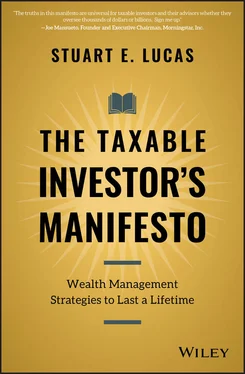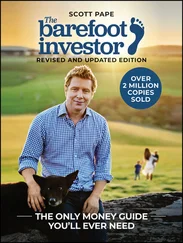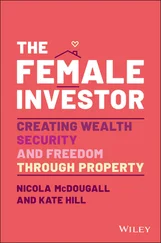Chapters 8and 9describe opportunities for those with greater scale and the inclination for complexity to add incremental investment value net of taxes. In addition to considerable analytical skill, this requires excellent judgment about people and opportunity – judgment born of experience and independent thinking. Possibly the most difficult challenge here is allocating and reallocating capital effectively. As a taxable investor, every time you sell a successful investment you must share your gains with the government. Every time you pay tax, you are left with a smaller base of capital on which to compound returns going forward. If you're an advisor, every time your client pays investment-related taxes, those are assets on which you no longer earn fees. This complexity is not shared by tax-exempt investors or their advisors. It requires different perspective and special skill.
Chapters 10, 11, and 12integrate the business, financial, and cultural elements of managing a complex, potentially multigenerational, family enterprise. At their core, family enterprises require values and vision that support a strong economic engine and a flourishing family. They also must navigate complex estate taxes and the evolution of control and ownership from one generation to the next. Building and managing all this in the face of change, uncertainty, and timeframes that can approach 50 years or more is no small challenge, but it can be done, and the results are powerful.
Chapter 13is a reminder to everyone that investing involves risk. I explore the key risks to investing in this way, at least the ones I can foresee. It's important to process the risks to be alert to them and to not be distracted by the inevitable ups and downs of market movements that are unavoidable parts of the landscape.
Many wealth owners reading this manifesto are mulling over whether to manage their financial assets themselves or to hire an advisor to help them. Having read it, I believe that most will be convinced that choosing a skilled advisor is instrumental to long-term success. You will also have increasing conviction to identify the right advisor, hold them accountable, and compensate them appropriately. The right talent comes at a price but pays for itself many times over. In Chapter 14, I discuss how to choose the advisor you need to help you accomplish your objectives. The answer varies depending on your scale, the complexity of your circumstances, and your time horizon. The challenge is to find a person or team who offers what you need, has the mindset and skills to deliver on their promise, and whose interests are aligned with yours.
A word about financial advisors: many find themselves in a bind. Why? They know how difficult it is to beat the market, but they also know clients will pay them for advice that feels complicated even if it's unlikely to work. Even when advisors know that clients will get better results with a more straightforward solution, they fear that clients won't pay for what sounds simple and straightforward. The thinking goes that indexing is cheap and doesn't add value, so why pay an advisor to recommend it?
This manifesto illuminates a path out of this bind, to the benefit of both wealth owners and their advisors. There is so much value creation that goes into comprehensive, strategic, after-tax wealth management that has largely gone unrecognized, undelivered, unmeasured, and unpaid for. Looking forward, we can change this. Taxable investors deserve to get good advice and advisors deserve to get paid fairly for delivering it.
1 1One of my favorite quotes from John “Jack” Bogle, the founder of Vanguard Group, comes from his April 13, 2004, “Gary M. Brinson Distinguished Lecture,” where he speaks about why it was taking so long for indexing to catch on: “The problem faced by low cost no-load index funds is that … almost all the darn money goes to the investor.” For decades, index funds struggled to gain attention, in part because their “rents” were so low that the fund managers had few dollars to spend on marketing. Fourteen years later, in 2018, according to Morningstar, Inc., $301 billion flowed into index funds and $458 billion flowed out of active management. Investors are (finally) catching on and roughly $2 billion in annual “rent” charged by active managers evaporated.
CHAPTER ONE Taxable Investors Need to Think Differently
What makes a good investment? It's such a simple question, but not an easy one to answer. We never know in advance whether an investment will succeed. By their very nature, investments involve uncertainty. Nevertheless, one can evaluate proactively whether something is a good investment. To me, a good investment has more upside potential than downside risk; it's asymmetric. The investment becomes even more attractive when its upside can compound for a long time; it has high potential magnitude. A third valuable attribute is a favorable probability of success; 30% odds of doubling one's money is a lot better than 10% odds of doing so.
Another important characteristic that drives investment attractiveness is the percentage of the profit from a successful investment that the investor actually keeps, profit retention. Profit retention is different than asymmetry, magnitude, and probabilities because taxable and tax-exempt investors operate with different rules. A tax-exempt investor – like an endowment, foundation, or retirement plan – may keep 90% or more of the profits from a high-yield bond fund each year, and it can reinvest the entire 90%. The other 10% or so goes to the fund manager in the form of fees. On the other hand, a taxable investor based in California or New York earns and can reinvest maybe 50% of the profits because, in addition to paying the investment manager, the taxable investor must also pay taxes on income and capital gains. Through the lens of that taxable investor, the management fees aren't 10% of retained profits; they are more like 20% of the after-tax return. It's the same investment but with very different results. For hedge funds the tax-exempt investor keeps maybe 75% because of the higher fee structure. On the same investment, the taxable investor nets 45% or less. 1
Retaining 75% to 90% of the same gross profits versus 45% to 50% can have profound effects on symmetry, magnitude, and probability assessments, especially when asset growth compounds over years and decades. But almost no one – academics, advisors, clients – has done the math, measured the differences, and adapted investment strategy or tactics to take these differences into account.
When we pay tax, that portion of profit goes to the government and is no longer in our portfolio. It can't grow for us, it can't pay dividends, it's removed from an advisor's assets under management. On the other hand, if tax payments on an investment can be deferred, the amount that otherwise would be used to pay tax in a given year has the potential to keep compounding, indefinitely.
Success as taxable investors comes with additional challenges. The more we defer tax payments and the higher the magnitude of the gain, the bigger the tax bill at the eventual sale. A highly appreciated asset worth $1 million and paying a 2% dividend before tax could, after it is sold, end up being worth only $750,000 after capital gains taxes are paid. Over time, any replacement investment needs to appreciate at a faster rate than the old one just to break even in dollar terms, and it needs to generate a 33% dividend boost to maintain cash flow. This isn't an issue for tax-exempt investors, and their investment managers have no need to think through the problem.
Being seen as a successful money manager is good business. Skillfully crafted brochures and sales pitches describe investment processes that involve careful analysis of investment options, how decisions are made to buy the best ones, regular reevaluation of those decisions as relative values change, and how to upgrade the portfolio to achieve the best possible results. Tax-exempt investors are indifferent about whether a manager makes a thousand decisions a minute, ten a week, five a month, two a year, or none at all, as long as the results are there.
Читать дальше












